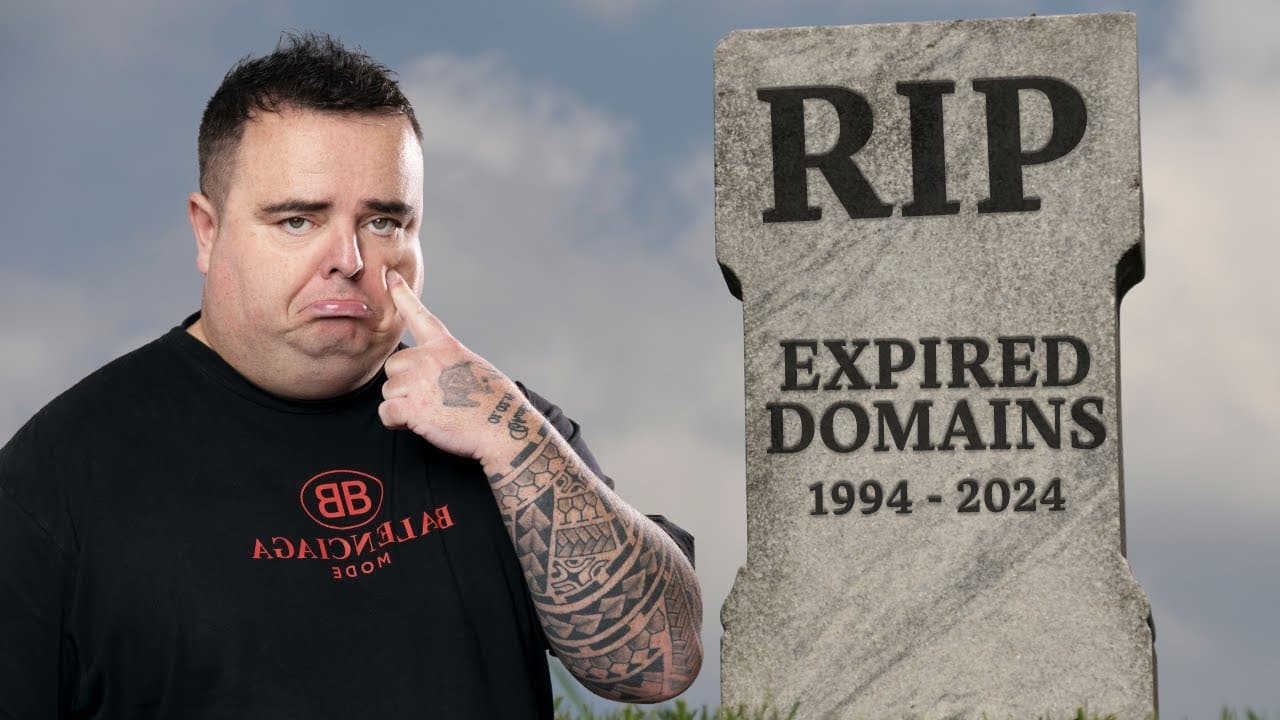
The March Google core update focuses on dealing with expired domain abuse. However, using expired domains has long been a common strategy for achieving good rankings. In my experience, expired domains can be hit or miss, and their effectiveness depends on various factors, such as whether they are being worked on.
It’s important to note that expired domains also decay over time unless they are maintained. Google’s approach to dealing with expired domain abuse is not new, and it’s easy for them to discount links from expired domains that were registered after the domain expired. Therefore, as part of this update, it’s recommended to focus on aged non-drop domains, which carry more power and have a higher chance of success.
[embedded content]
Key Takeaways
- Expired domains have been a common strategy for achieving good rankings, but their effectiveness depends on various factors.
- Google’s approach to dealing with expired domain abuse is not new, and it’s recommended to focus on aged non-drop domains as they have a higher chance of success.
- Maintaining domains is crucial to prevent decay over time.
March Google Core Update Overview
As part of the March Google core update, Google targets content and deals with expired domain abuse. However, this is not new, as many people have been using expired domains for a long time to get good rankings. From my experience, expired domains can be hit or miss and decay over time unless they are being worked on.
Google’s announcement about dealing with expired domain abuse may have caused some scaremongering, but it is not new. Google can easily discount all the links a website had previously if it were registered again after expiration. Therefore, it is essential to consider aged, non-dropped domains, which carry more power and have a higher chance of success.
Expired domains can be effective if you build something on them, build links to them, and drive traffic to them. However, they decay over time, and if you do not work on them, their rankings will drop. Therefore, it is crucial to work on them continuously.
In conclusion, while Google is dealing with expired domain abuse, it is not something new and can be easily dealt with. Aged non-dropped domains are still an effective strategy, and it is essential to consider them. Continuously working on your website and building links to it is crucial for its success.
Expired Domain Abuse
As an experienced SEO, I know that using expired domains can be hit or miss. While they can be leveraged to get good rankings, they also decay over time unless they are being worked on. Google’s March core update claims to deal with expired domain abuse, but this is not really a new thing. Many people have been using expired domains for a long time to get good rankings.
I recently had an expired domain, the Nigel Farage website, which used to be a DR50 and used to get a lot of traffic. However, the website decayed over time because I did not update the content, drive traffic to it, or build any links. This is also true for expired domains unless they are being worked on.
Google can easily deal with expired domain abuse by discounting all of the links that the expired domain had previously and only counting the links that were built on it after it was re-registered. This is not new, and it is easy for Google to dismiss anything that happened before the domain was re-registered.
It is important to note that there is a big difference between an expired domain and a non-dropped domain. Aged non-dropped domains carry a lot more power and are more successful in getting good rankings. As part of the March core update, it is important to consider this and prefer non-dropped domains over expired ones. Blindly dismissing expired domains is not the answer. Instead, use common sense, do testing, and leverage non-dropped domains for better results.
Effectiveness of Expired Domains
As an experienced SEO, I can confidently say that expired domains can be hit or miss in terms of their effectiveness. While they can be leveraged to get good rankings, they decay over time unless they are being worked on. This means that if you are simply doing 301 redirects and not building any links, decay will continue.
However, if you build out something on an expired domain, build links to it, and drive traffic to it, it can be an effective strategy. It’s important to note that Google is now claiming to deal with expired domain abuse as part of their March core update targeting content.
While some people may be dismissing expired domains altogether, I would always prefer to go for an aged, non-dropped domain. There is a big difference between an expired and a non-dropped domain, and you are likely to get more success with the latter.
It’s also worth noting that Google can easily discount all of the links that a previously expired domain had if it has been re-registered. This means that it’s important to take into account when something has been registered as part of this update.
In conclusion, while expired domains can be an effective strategy, it’s important to work on them and build them up. It’s also important to take into account the difference between expired and non-dropped domains and to consider the potential for Google to discount previously existing links.
Case Study: Nigel Farage Website
I recently experimented with an expired domain, the Nigel Farage website, to see how effective it could be in terms of search engine rankings. The website used to have a DR50 and receive a lot of traffic, but over time, it decayed due to lack of updates, traffic, and link building.
It is true that expired domains can be hit or miss and decay over time unless they are actively worked on. However, if you build something on them, build links to them, and drive traffic to them, the rankings will improve, and it can be an effective strategy.
Google is now claiming to deal with expired domain abuse, but this is not a new thing. It has been a common practice for many years to use expired domains and leverage them to get good rankings.
In the case of the Nigel Farage website, it was registered to me on March 3, 2017, after Nigel Farage let his domain expire. Using the tools available to us, we can see when some of the links were first seen, and we can also see that the website has hundreds of top-tier links from sources such as Wikipedia, The Guardian, and BBC.
However, the website’s DR has fallen to 25 due to lack of content, traffic, and updates. It would be very easy for Google to discount all of the links that the Nigel Farage website had previously and dismiss anything that happened before it was registered to me.
It is important to note that there is a big difference between an expired and a non-dropped domain. Aged non-dropped domains carry more power and are more likely to be successful. As part of the March Google core update, it is important to take this into account and consider non-dropped domains when leveraging expired domains for SEO purposes.
Decay of Unused Expired Domains
As an experienced SEO, I can tell you that expired domains can be hit or miss. While they can be leveraged to get good rankings, they also decay over time unless they are worked on. Google is now claiming to deal with this as part of its March core update.
Take, for example, the Nigel Farage website that I recently acquired. It used to be a DR50 website with a lot of traffic, but as you can see in the screenshot, it has decayed over time. I have not driven any traffic to it, updated its content, or built any links.
Just like any other website, expired domains decay unless they are being worked on. If you are doing 301 redirects and not building anything on it, there will be decay. However, building out something on it, building links to it, and driving traffic to it can be an effective strategy.
Google is now saying that they will deal with expired domain abuse, which is not new. They can easily discount all of the links a website had previously if they see that the domain was registered again. This is why aged non-dropped domains are preferred over expired domains. There is a big difference between an expired and a non-dropped domain, and you will be more successful with a non-dropped domain.
In conclusion, it is important to take into account that expired domains do decay over time and that Google is now claiming to deal with expired domain abuse. Using common sense and doing testing is the best way to leverage domains for SEO purposes.
Strategies for Maintaining Domain Value
As an experienced SEO, I know that expired domains can be hit or miss. They can be an effective strategy if they are being worked on, but they also decay over time unless they are being updated and links are being built. Google’s March core update is targeting expired domain abuse, but this is not a new thing.
If you’re considering using expired domains, keep in mind that they also decay unless they’re being worked on. Therefore, it’s crucial to build something on them, build links to them, and drive traffic to them in order to maintain their value.
Aged non-dropped domains are preferred over expired domains. There is a big difference between an expired and a non-dropped domain, and you’re more likely to succeed with a non-dropped domain. As part of the update, it’s important to consider this and consider using non-dropped domains instead of expired ones.
In summary, using common sense and testing is important when considering using expired domains. Building a website on an expired domain, building links, and driving traffic to it can help maintain its value. However, if possible, it’s always better to go for a non-dropped domain.
Google’s Approach to Expired Domains
As an experienced SEO, I can tell you that using expired domains can be hit or miss. While they can effectively get good rankings, they also decay over time if not appropriately maintained. Google has recently claimed to deal with expired domain abuse as part of its March core update targeting content.
However, this is not a new thing. Expired domains have been used for a long time to leverage good rankings. But unless they are being worked on, they also decay over time. If you’re doing 301 redirects and not updating the content or building links, there will be decay.
Google can easily discount all of the links that a website had previously if it was registered again after being expired. For instance, if I look at the Nigel Farage website, which used to be a DR50 website, it has decayed over time because I haven’t driven any traffic to it, updated the content, or built any links. It is now just a DR25 website.
However, Google can dismiss anything that happened before the domain was re-registered. This is not new, and it should not scare people away from using expired domains. Aged non-drop domains are still effective, and they carry a lot more power than dropped domains.
If you want to leverage expired domains, use some common sense, do testing, and go for non-drop domains. This is essential to take into account as part of the update. Blindly dismissing expired domains is not a wise decision.
Advantages of Aged Non-Drop Domains
As an experienced SEO, I can confidently say that aged non-drop domains are the way to go if you want to succeed in your rankings. While expired domains can be hit or miss, non-drop domains carry much more power and have a higher chance of success.
Google’s recent update claims to deal with expired domain abuse, but this is not necessarily a new thing. Many people have been using expired domains for a long time to leverage their rankings. However, expired domains decay over time unless they are being worked on. This is where non-drop domains come in.
Non-drop domains do not expire and do not need to be continuously worked on to maintain their power. They also benefit from being aged, which means they have been around for a longer time and have accumulated more authority. This makes them a more stable and reliable option for achieving higher rankings.
Furthermore, Google’s update on expired domain abuse does not affect non-drop domains. This means they are a safer option for SEOs who want to avoid any potential penalties or negative impacts on their rankings.
In conclusion, while expired domains can be effective, non-drop domains are a more reliable and stable option for achieving success in your SEO efforts. They carry more authority, are not affected by Google’s update on expired domain abuse, and do not require continuous work to maintain their power. As an SEO, I highly recommend considering aged non-drop domains as part of your SEO strategy.
Misconceptions and Scaremongering
As an experienced SEO, I know that expired domains have been used for a long time to boost rankings. However, it is important to note that they can be hit or miss. In fact, any expired domain that is not being worked on will eventually decay and lose its power.
Google’s March core update claims to deal with expired domain abuse, but this is not necessarily a new thing. Google can easily discount all of the links that a website had previously if it was registered again after expiring. This means that if you are using expired domains, it is important to make sure that you are constantly working on them by building links, updating content and driving traffic to maintain their power.
There is a lot of scaremongering going on about expired domain abuse being a part of the update. However, it is important to note that aged non-dropped domains carry a lot more power and are a better option. It is always better to go for a non-dropped domain, as there is a big difference between an expired and a non-dropped domain.
It is important to use common sense and do testing to see what works best for you. In conclusion, if you want to leverage expired domains, work on them to maintain their power constantly. However, aged non-dropped domains are still the best option and should be considered as part of this update.
Recommendations for Domain Acquisition
As an experienced SEO, I have found that using expired domains can be a hit-or-miss strategy. While they can be effective if worked on properly, they decay over time if not maintained. Therefore, it is important to consider the following recommendations when acquiring domains:
- Prioritise Non-Dropped Domains: Aged non-dropped domains carry more power and can be more effective in achieving good rankings. Therefore, it is recommended that non-dropped domains be prioritised when acquiring domains.
- Work on the Domain: To prevent decay, it is important to work on the domain by building links, driving traffic, and updating content. This will help improve the domain’s rankings and effectiveness.
- Avoid Expired Domain Abuse: Google now claims to deal with expired domain abuse, so it is important to avoid using expired domains that may be penalised. Instead, prioritise non-dropped domains and work on them properly.
- Use Common Sense and Testing: It is important to use common sense and do testing when acquiring domains. Blindly dismissing expired domains or relying solely on non-dropped domains may not always be the best strategy. Therefore, it is important to do testing and use common sense when acquiring domains.
In conclusion, when acquiring domains, it is important to prioritise non-dropped domains, work on the domain to prevent decay, avoid expired domain abuse, and use common sense and testing. Following these recommendations can help you effectively acquire domains and achieve good rankings.

